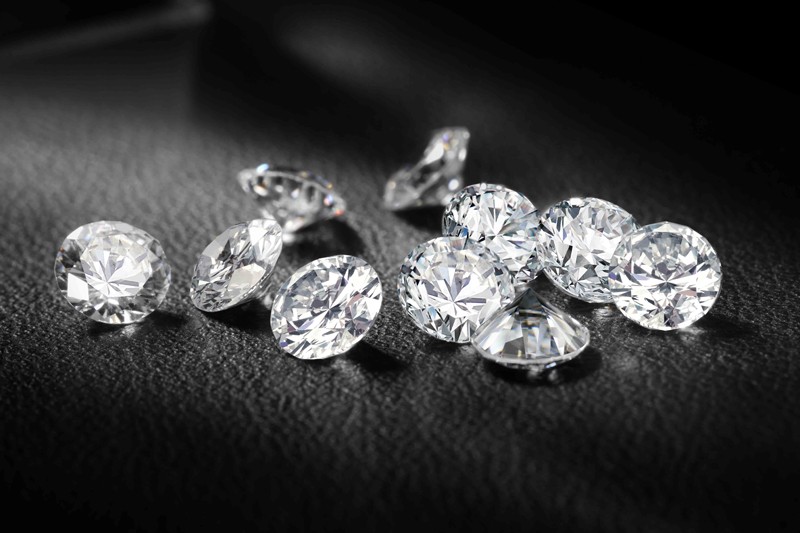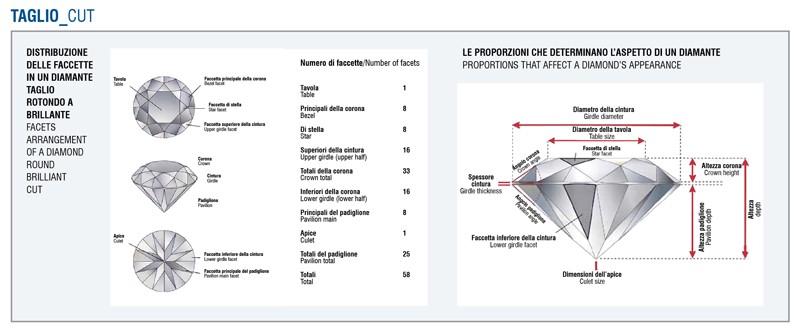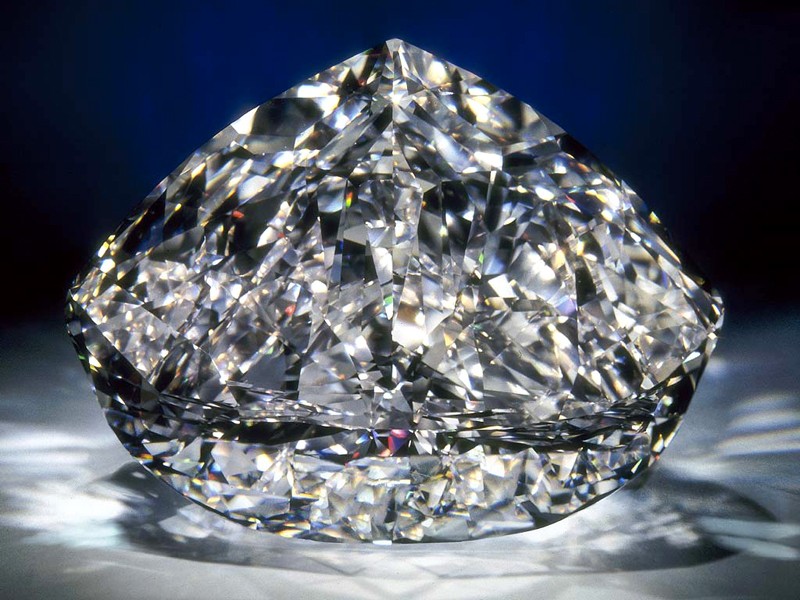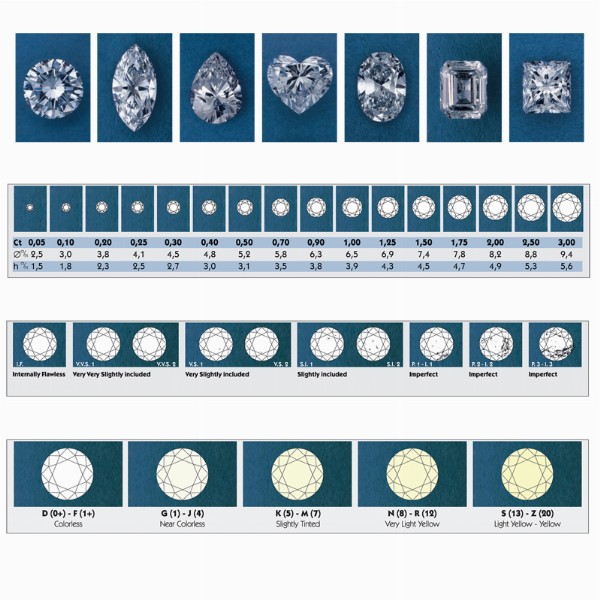Comparing the cut of the diamond to Michelangelo’s Neo-Platonist idea on sculpture is less imprudent than it may seem.
According to him, sculpture is “what is done by removing” (“si fa per via di levare”): with his chisel, the artist sets the work already present in the block of marble free and therefore hidden beauty is revealed by taking away the unnecessary.
As the sculptor in Michelangelo’s view brings the work to life by removing superfluous material, the same happens for the cutter extracting a shining gem by removing raw material. Thanks to his skill, the fabulous optical qualities of the diamond, innate and hidden inside the natural crystal, burst from the faceted gem. The shine typical of a well-cut and polished diamond is so peculiar to be called “adamantine” luster, from the Greek adamas (the indomitable).
The cut can be defined as the human contribution to the beauty of gems. It has such a relevant influence on the aspect and the attractiveness of a gem that it affects also its value.
DIAMOND FOUR Cs
The parameters considered to evaluate a cut diamond are indicated by the English term “4 C”: Carat, Colour, Clarity, Cut. Even if this latter is as important as other parameters, frequently it is the most neglected one.
Usually, during a transaction, besides carat size, especially Colour and Clarity of the gem is taken into consideration, forgetting or ignoring the importance of the quality of Cut.
When starting working on a rough diamond, cutters must face a dilemma between the aesthetic result and the preservation of the highest weight possible, aiming at reaching the best compromise. The crystal habit, which is the shape of the rough diamond, influences the choice of the final shape; for example, from an octahedral crystal it is possible to cut a brilliant round gem, from a flat and long crystal it will be possible to obtain a pear or a navette.
While cutting you lose on average 50% of the initial weight.
Since cut influences also the other qualitative factors, the cutter must be able to foresee the final result, evaluating the potential of the crystal also in terms of Colour and Clarity. Colour can be intensified or diminished according to the quality of the cut. For example, the rare pink diamonds might lose their precious colour due to invisible mistakes in the cut, with serious economic consequences.
Possible inclusions might be profitably cancelled, disguised or glossed over by skilful expedients. To give an idea of the delicacy of the decisions on cut, it is worth mentioning the three-year study (1988–1991) for Gabriel Tolkowsky’s team (one of the most famous and skilled cutter in the world, Marcel Tolkowsky’s grandnephew of whom I will be talking later on), to transform an amazing 599 carats (119,80 grams) rough diamond, found in the Premier Mine in South Africa on 17 July 1986, into the fabulous 273,85 carats (54,77 grams) Centenary Diamond. Of course, this is an extreme example, but it is relevant to understand that the final result of all diamonds depends on the careful decisions made by cutters.
In gemmology, Cut means the combination of all facets, the style of faceting (brilliant, step, radiant, etc.), the finishing, and the proportions; shape means the outline of the stone seen from above.
So, diamond is the mineral formed by carbon crystallizing in the cubic crystal system, formed in the mantle – under the earth’s surface – at high temperature and pressure, while the brilliant is one of the possible cuts of the diamond, and in general of all natural and artificial gems. The round brilliant cut, formed by 58 facets (57 if the cutlet is pointed) is the most common, and, in fact, the cut (brilliant) is currently identified with the mineral (diamond) when the term is used with no further specifications about the substance it is taken from.
Other shapes, such as rectangular with cut corners, navette (or marquise), drop, oval, heart and so on, depend more on fashion trends, personal tastes and geographical areas, so that in some countries some forms can be preferred to others and therefore become more valuable.
Finishing means the accuracy dedicated by the cutter at realizing his work. It includes Symmetry and Polish. Symmetry is the balanced and regular correspondence among parts forming the faceted stone. The majority of the diamonds have symmetry variations, such as an imprecise circumference in round shapes, variable thickness of the girdle, distorted facets, slight or prominent differences with respect to the theoretic shape, with various influences on the final aspect. Polish is the condition of the surface, which must have no scratches, abrasions, irregularities, marks due to the cutting and chippings. These are external damages caused by manufacturing or usage. These imperfections can be removed through a new polishing with a minimum loss of weight.
Diamond is famous for being the hardest mineral, but frequently common opinion confuses the concepts of hardness and toughness. Hardness represents the resistance to abrasion and scratch; toughness is the resistance to fracture and cleavage. A diamond can be scratched only by another diamond; however, it is not immune from breaking because of the presence of four systems of cleavage.
Cleavage is a break parallel to certain directions in the crystal’s pattern of atomic arrangement. If the crystal broke according to irregular surfaces, we can talk about fracture.
As a proof that diamond is not indestructible, sometimes along the circumference it is possible to see some chippings, hidden under the griffes of the frame, frequently caused by imprecise setting operations.
A fall can cause damages too, compromising the cutlet or the points of a drop or a navette.
If the preservation of the weight was the only objective of the cutter, he would not mind realizing suggestive optical effects so sought-after in the diamond. The maximum of brightness, fire and scintillation is emphasized by the application of mathematical principles within a limited variation, beyond which the beauty and the value of the diamond would be compromised.
Each facet and portion of the stone contribute to the exaltation of its beauty. The relation and the interaction between the dimensions of the facets and the angles of crown and pavilion are fundamental for the sparkling of the gem, so that well-cut diamonds are more brilliant with respect to those treated with less painstaking attention. In a round brilliant, correct combinations among percentage of the table, angles of the crown and the pavilion are fundamental in exalting the brightness, meaning the effect caused by the internal and external reflection of the light.
The flashes of vivid colours (blue, orange...) coming from a cut diamond are the fire. These, coming mainly from the facets of the crown, are due to the dispersion of the white light which is separated in the colours of the spectrum. The balance between sparkling and dispersion depends mainly on the dimension of the table and from the angle formed by the crown with the plane of the girdle. In general, large tables and flat crown angles have a negative effect on the fire, which depends on the angle of the pavilion, the length of the star facets and the length of the inferior facets of the girdle.
The scintillation is the visible flashing when the stone or the luminous source are moving. The contrast between luminous and dark areas must be well balanced. Prominent dark areas, reflexes of the cutlet on the crown or the so-called “fish eye”, which is the whitish reflex of the girdle around the table, are some examples of effects impoverishing the aspect of the gem when observed from above.
All parts of the Cut are judged by a gemmological laboratory.
The judgment on Symmetry and Polish is given according to the visibility with 10 enlargements (loupe and microscope) of the characteristics above mentioned. Judgments given by the GIA (Gemmological Institute of America) are five: Excellent, Very Good, Good, Fair, Poor. The Italian rule currently in force (UNI 9758 Diamante - Terminologia, classificazione, caratteristiche e metodi di prova, of July 2003) gives four degrees: Excellent, Good, Medium, Poor. As a consequence, it is easy to understand that the results of the judgments on the same stone can be different.
Proportions are evaluated with specific instruments, the proportiometers.
In classifying the cut, the GIA introduced important novelties. After fifteen years of research on more than 2,300 samples, the American institute developed the new Cut grade, a classification system applied only to diamonds with round brilliant cut and colour in the range D-Z, applied in the GIA Reports since 2006. The degrees of cut are five: Excellent, Very Good, Good, Fair, Poor. The final evaluation of the cut is determined by proportions and finishing. Compared to other classification systems, the GIA does not consider single proportions separately, as independent by one another, but evaluates the way in which they interact with each other. The beauty of a diamond is given by the sum of all its parts and therefore the interaction among parameters determines the final judgment. From this three-dimensional evaluation, it is clear that there is not a unique set of proportions, a unique recipe to obtain an optimal cut, but there are various possible combinations. And in fact two diamonds with the same Cut grade may not have the same aspect.
Diamonds, with the same qualitative parameters (Carat, Colour, Clarity), obtaining Excellent in Cut grade in Polish and in Symmetry are the most precious.
Fair and Poor diamonds are frequently re-cut to improve their quality.
On the market, if all other parameters are equal, if a stone has Good in Symmetry
According to him, sculpture is “what is done by removing” (“si fa per via di levare”): with his chisel, the artist sets the work already present in the block of marble free and therefore hidden beauty is revealed by taking away the unnecessary.
As the sculptor in Michelangelo’s view brings the work to life by removing superfluous material, the same happens for the cutter extracting a shining gem by removing raw material. Thanks to his skill, the fabulous optical qualities of the diamond, innate and hidden inside the natural crystal, burst from the faceted gem. The shine typical of a well-cut and polished diamond is so peculiar to be called “adamantine” luster, from the Greek adamas (the indomitable).
The cut can be defined as the human contribution to the beauty of gems. It has such a relevant influence on the aspect and the attractiveness of a gem that it affects also its value.
DIAMOND FOUR Cs
The parameters considered to evaluate a cut diamond are indicated by the English term “4 C”: Carat, Colour, Clarity, Cut. Even if this latter is as important as other parameters, frequently it is the most neglected one.
Usually, during a transaction, besides carat size, especially Colour and Clarity of the gem is taken into consideration, forgetting or ignoring the importance of the quality of Cut.
When starting working on a rough diamond, cutters must face a dilemma between the aesthetic result and the preservation of the highest weight possible, aiming at reaching the best compromise. The crystal habit, which is the shape of the rough diamond, influences the choice of the final shape; for example, from an octahedral crystal it is possible to cut a brilliant round gem, from a flat and long crystal it will be possible to obtain a pear or a navette.
While cutting you lose on average 50% of the initial weight.
Since cut influences also the other qualitative factors, the cutter must be able to foresee the final result, evaluating the potential of the crystal also in terms of Colour and Clarity. Colour can be intensified or diminished according to the quality of the cut. For example, the rare pink diamonds might lose their precious colour due to invisible mistakes in the cut, with serious economic consequences.
Possible inclusions might be profitably cancelled, disguised or glossed over by skilful expedients. To give an idea of the delicacy of the decisions on cut, it is worth mentioning the three-year study (1988–1991) for Gabriel Tolkowsky’s team (one of the most famous and skilled cutter in the world, Marcel Tolkowsky’s grandnephew of whom I will be talking later on), to transform an amazing 599 carats (119,80 grams) rough diamond, found in the Premier Mine in South Africa on 17 July 1986, into the fabulous 273,85 carats (54,77 grams) Centenary Diamond. Of course, this is an extreme example, but it is relevant to understand that the final result of all diamonds depends on the careful decisions made by cutters.
In gemmology, Cut means the combination of all facets, the style of faceting (brilliant, step, radiant, etc.), the finishing, and the proportions; shape means the outline of the stone seen from above.
So, diamond is the mineral formed by carbon crystallizing in the cubic crystal system, formed in the mantle – under the earth’s surface – at high temperature and pressure, while the brilliant is one of the possible cuts of the diamond, and in general of all natural and artificial gems. The round brilliant cut, formed by 58 facets (57 if the cutlet is pointed) is the most common, and, in fact, the cut (brilliant) is currently identified with the mineral (diamond) when the term is used with no further specifications about the substance it is taken from.
Other shapes, such as rectangular with cut corners, navette (or marquise), drop, oval, heart and so on, depend more on fashion trends, personal tastes and geographical areas, so that in some countries some forms can be preferred to others and therefore become more valuable.
Finishing means the accuracy dedicated by the cutter at realizing his work. It includes Symmetry and Polish. Symmetry is the balanced and regular correspondence among parts forming the faceted stone. The majority of the diamonds have symmetry variations, such as an imprecise circumference in round shapes, variable thickness of the girdle, distorted facets, slight or prominent differences with respect to the theoretic shape, with various influences on the final aspect. Polish is the condition of the surface, which must have no scratches, abrasions, irregularities, marks due to the cutting and chippings. These are external damages caused by manufacturing or usage. These imperfections can be removed through a new polishing with a minimum loss of weight.
Diamond is famous for being the hardest mineral, but frequently common opinion confuses the concepts of hardness and toughness. Hardness represents the resistance to abrasion and scratch; toughness is the resistance to fracture and cleavage. A diamond can be scratched only by another diamond; however, it is not immune from breaking because of the presence of four systems of cleavage.
Cleavage is a break parallel to certain directions in the crystal’s pattern of atomic arrangement. If the crystal broke according to irregular surfaces, we can talk about fracture.
As a proof that diamond is not indestructible, sometimes along the circumference it is possible to see some chippings, hidden under the griffes of the frame, frequently caused by imprecise setting operations.
A fall can cause damages too, compromising the cutlet or the points of a drop or a navette.
If the preservation of the weight was the only objective of the cutter, he would not mind realizing suggestive optical effects so sought-after in the diamond. The maximum of brightness, fire and scintillation is emphasized by the application of mathematical principles within a limited variation, beyond which the beauty and the value of the diamond would be compromised.
Each facet and portion of the stone contribute to the exaltation of its beauty. The relation and the interaction between the dimensions of the facets and the angles of crown and pavilion are fundamental for the sparkling of the gem, so that well-cut diamonds are more brilliant with respect to those treated with less painstaking attention. In a round brilliant, correct combinations among percentage of the table, angles of the crown and the pavilion are fundamental in exalting the brightness, meaning the effect caused by the internal and external reflection of the light.
The flashes of vivid colours (blue, orange...) coming from a cut diamond are the fire. These, coming mainly from the facets of the crown, are due to the dispersion of the white light which is separated in the colours of the spectrum. The balance between sparkling and dispersion depends mainly on the dimension of the table and from the angle formed by the crown with the plane of the girdle. In general, large tables and flat crown angles have a negative effect on the fire, which depends on the angle of the pavilion, the length of the star facets and the length of the inferior facets of the girdle.
The scintillation is the visible flashing when the stone or the luminous source are moving. The contrast between luminous and dark areas must be well balanced. Prominent dark areas, reflexes of the cutlet on the crown or the so-called “fish eye”, which is the whitish reflex of the girdle around the table, are some examples of effects impoverishing the aspect of the gem when observed from above.
All parts of the Cut are judged by a gemmological laboratory.
The judgment on Symmetry and Polish is given according to the visibility with 10 enlargements (loupe and microscope) of the characteristics above mentioned. Judgments given by the GIA (Gemmological Institute of America) are five: Excellent, Very Good, Good, Fair, Poor. The Italian rule currently in force (UNI 9758 Diamante - Terminologia, classificazione, caratteristiche e metodi di prova, of July 2003) gives four degrees: Excellent, Good, Medium, Poor. As a consequence, it is easy to understand that the results of the judgments on the same stone can be different.
Proportions are evaluated with specific instruments, the proportiometers.
In classifying the cut, the GIA introduced important novelties. After fifteen years of research on more than 2,300 samples, the American institute developed the new Cut grade, a classification system applied only to diamonds with round brilliant cut and colour in the range D-Z, applied in the GIA Reports since 2006. The degrees of cut are five: Excellent, Very Good, Good, Fair, Poor. The final evaluation of the cut is determined by proportions and finishing. Compared to other classification systems, the GIA does not consider single proportions separately, as independent by one another, but evaluates the way in which they interact with each other. The beauty of a diamond is given by the sum of all its parts and therefore the interaction among parameters determines the final judgment. From this three-dimensional evaluation, it is clear that there is not a unique set of proportions, a unique recipe to obtain an optimal cut, but there are various possible combinations. And in fact two diamonds with the same Cut grade may not have the same aspect.
Diamonds, with the same qualitative parameters (Carat, Colour, Clarity), obtaining Excellent in Cut grade in Polish and in Symmetry are the most precious.
Fair and Poor diamonds are frequently re-cut to improve their quality.
On the market, if all other parameters are equal, if a stone has Good in Symmetry



